
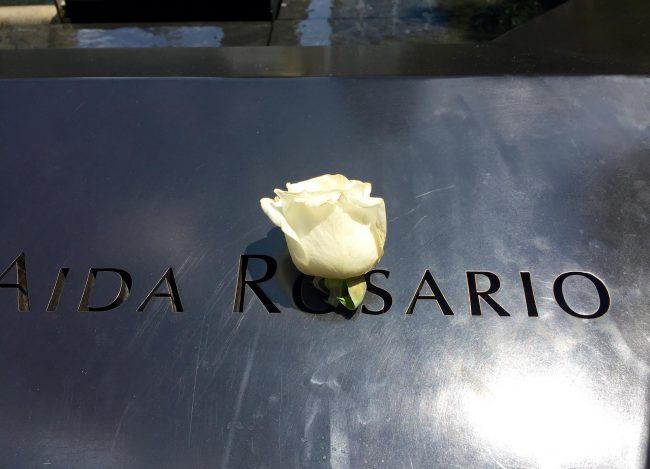
Where were you on 9/11?
Everyone remembers where they were and what they were doing during the catastrophic events of 9/11/2001 in New York City.
Many of us (an estimated two billion) saw the second plane hit the South Tower of the World Trade Center and witnessed the collapse of both towers live in person or on TV.
Reruns of the day’s horrific events and their aftermath played repeatedly on TV, online and in print.
The impact was no less as emotional when I visited the 9/11 Memorial & Museum in lower Manhattan.
Visiting the 9/11 Memorial
Our first view of it is from the car driving into the city from New Jersey. The tallest building and its spire stand above all others in the skyline.
The Memorial rises triumphantly as a monument to the human spirit and a testament to the value of human life.
We begin our remembrance on the outdoor plaza of the World Trade Center.
Hundreds of people quietly and reverently mill around two deep square pools with waterfalls—the largest man-made waterfalls in the country—pouring from all four sides into a deeper square in the middle.
Called Reflecting Absence, these pools outline the footprints of each tower. Architects Michael Arad and Peter Walker created them to symbolize the loss of lives.
All around the rims the names of the 2983 people who died in the attacks—both on 9/11 and the 1993 bombing that took place there—are etched in bronze.
Some people are seeking names they knew; others, like me, are reading them like a who’s who of an historic event.
Inside the museum (the tall, tall glass building), exhibits are divided into three sections: Before 9/11, the Day of 9/11 and After 9/11. There’s also an auditorium where free daily programs and films are shown.
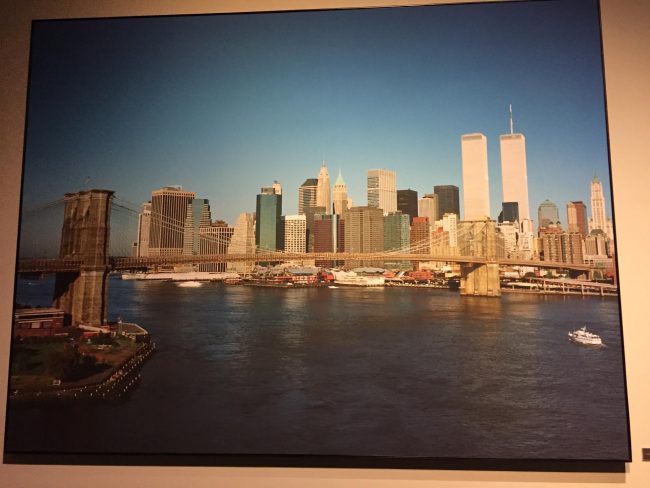
Make sure you see all the sights with a New York Pass by Go City.
Before 9/11
Photos and text in the first exhibit describe the World Trade Center Twin Towers that were completed in 1970 and 1972 to revitalize Lower Manhattan: 12 million square feet of office, hotel and commercial space; 1,200 restrooms; 40,000 doorknobs; 200,000 light fixtures and 200 elevators that rose from the lobby to the 107th floor in 82 seconds.
The entire complex was on 16 acres. Director of the World Trade Department Guy Tozzoli in 1962 issued a charge to architect Minoru Yamasaki: “President Kennedy is going to put a man on the moon.
You’re going to figure out a way for me to build the world’s tallest buildings.”
The twin towers, indeed, were the world’s tallest buildings at the dedication on April 4, 1973.
On that fateful day in 2001, they and five adjacent buildings were reduced to rubble and dust that spread for blocks and blocks throughout lower Manhattan.
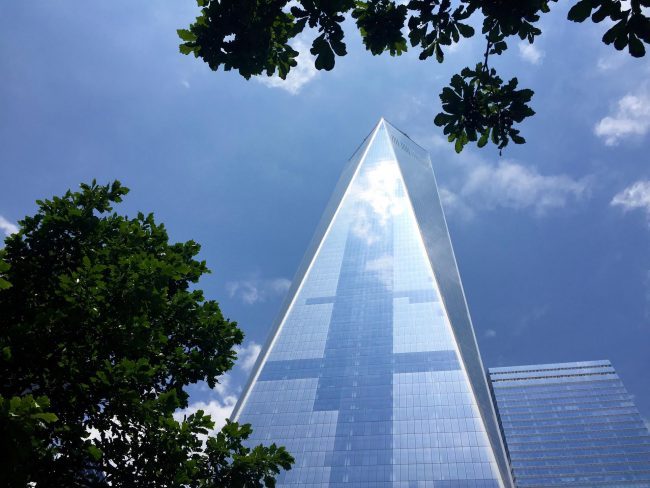
The Day of 9/11
This exhibit begins with photos and voices of people telling what they were doing and seeing at 8:46 on the morning of 9/11 when American Airlines Flight 11 hit the North Tower.
“We started running for our lives,” said one bystander. The most heartbreaking voice is a cell phone call from a man in the South Tower telling his wife he is OK because he’s in the tower that wasn’t hit.
Minutes later at 9:03 United Airlines Flight 175 exploded into the South Tower.
The rest of this exhibit shows videos, photos, artifacts and remnants left of the buildings. Horrific video shows people hurling themselves to their death rather than face burning in the fire.
Artifacts like the melted metal of Company 3 fire truck honor the first responders, many of whom were killed when the towers collapsed.
Twisted steel beams hit directly by the plane stand like burned trees in a forest. There are photos of people scrambling down what is now called “The Survivors’ Staircase.”
The actual staircase is here too. Many photos are painful to see. The crowd moves slowly, quietly, reverently from one display to the other.
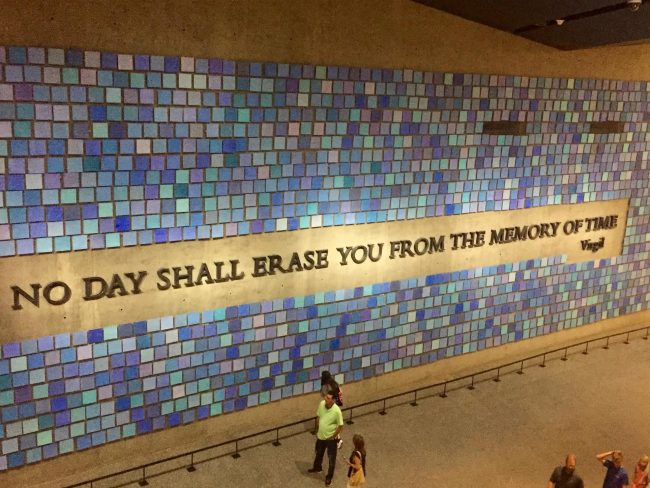
After 9/11: Memorial Hall
For me, this last exhibit is the most poignant. Memorial Hall begins with a huge art installation of tiles, each in a different shade of blue, asking if you remember the color of the sky on that September morn.
In the middle are words from Virgil: “No day shall erase you from the memory of time.” Behind the art installation is a repository of remains of unclaimed people.
One remnant known as the Last Column was part of the South Tower. This piece of steel was the last one removed from Ground Zero by first responders and workers.
As a tribute, they signed their names and left messages. Soon, family members of the victims added messages, and the column became a sacred place to share stories and feelings.
Then comes a beautiful, long tribute to the victims with photos and extensive bios of each one. No one is left out. Every single person no matter race or creed is as important as the next.
There’s a touch screen where people look for specific names. I am struck by a small display of a chef’s toque, kitchen utensils and recipe cards of Chef Clark who was the executive chef in the South Tower.
At the end of this exhibit, I notice a pedestal table with a box of tissues. By now, I need one.
Longterm Fallout from 9/11
Fires burned for months at Ground Zero. Tens of thousands of survivors, responders and residents still suffer from their exposure to toxins emitting from the site.
Illnesses like asthma and cancer have claimed the lives of hundreds, and many still suffer from depression and PTSD.
The Victims Compensation Fund was passed by Congress in 2010, and in 2015, it was extended for five additional years along with funding for the World Trade Center Health Program through 2090.
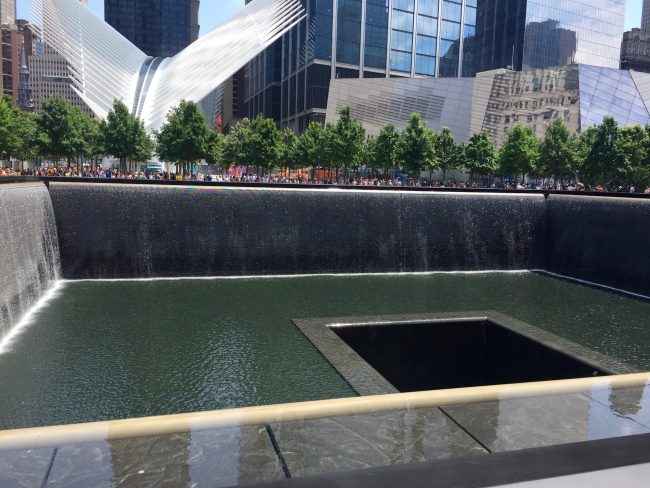
Marge Berdy was working as a designer in the garment district at the time of the attacks. She tells us about Women’s Wear Daily coming out with an article on “Flee Wear” for women soon after 9/11.
This collection was specific clothing to wear in case a woman needed to run quickly: flat-heeled shoes, flowing skirts (no long dresses or mini-skirts), and no scarves or long necklaces.
Let’s hope none of us ever must count on flee wear to save our lives.
National September 11 Memorial Mission Statement:
Remember and honor the thousands of innocent men, women and children murdered by terrorists in the horrific attacks of February 26, 1993 and September 11, 2001.
Respect this place made sacred through tragic loss.
Recognize the endurance of those who survived, the courage of those who risked their lives to save others, and the compassion of all who supported us in our darkest hours.
May the lives remembered, the deeds recognized, and the spirit reawakened be eternal beacons, which reaffirm respect for life, strengthen our resolve to preserve freedom, and inspire an end to hatred, ignorance and intolerance.
You can buy tickets for the museum online at www.911memorial.org. The Memorial Pools are free.
Make sure you see all the sights with a New York Pass by Go City.
